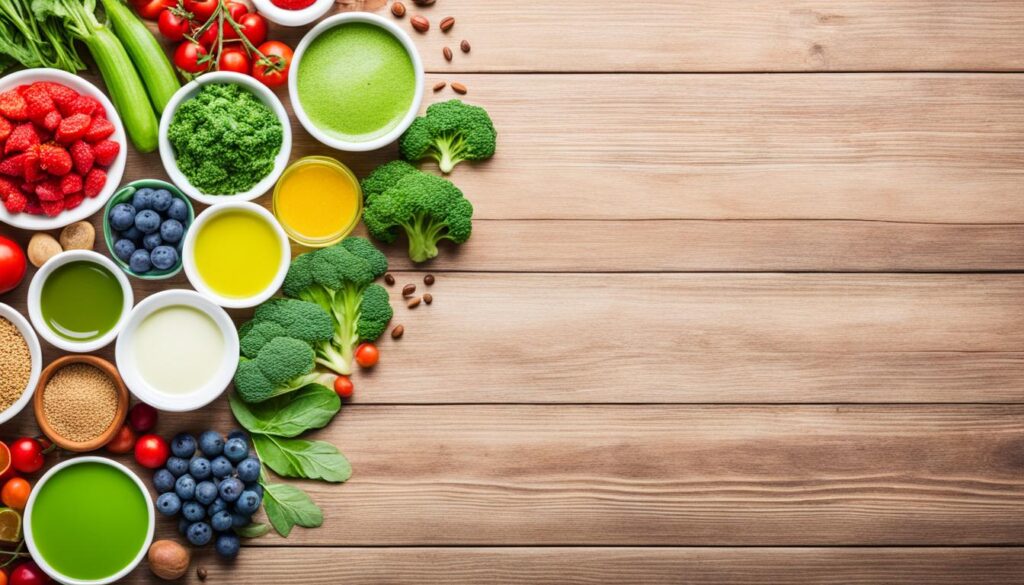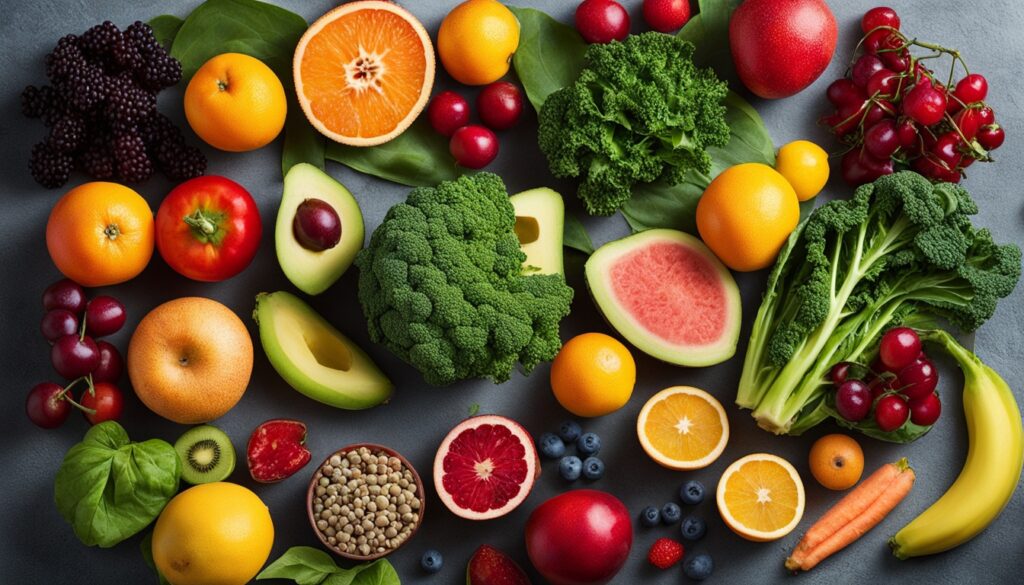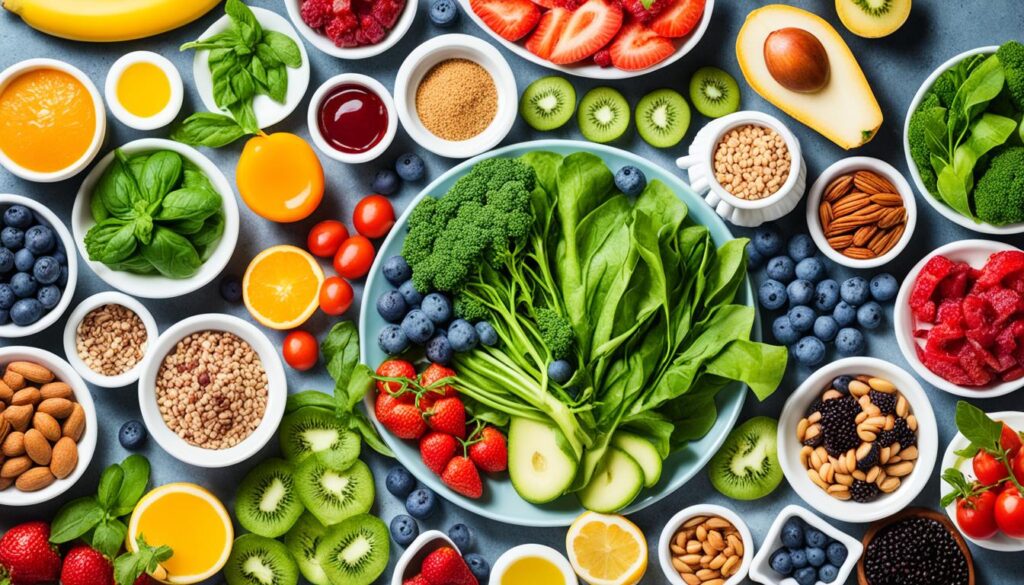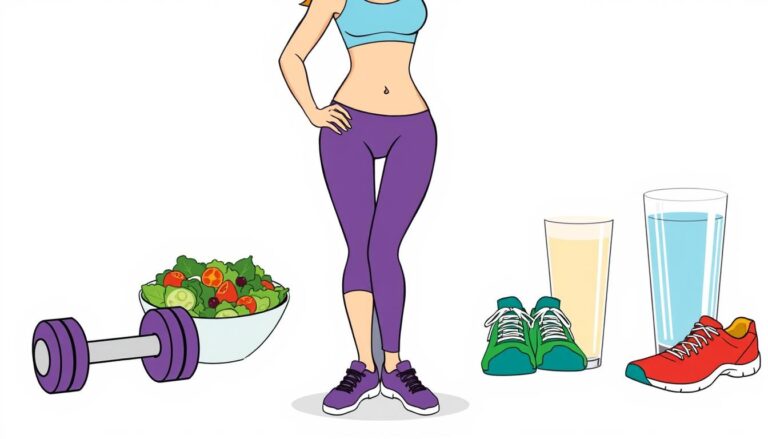What if you could manage your diabetes by making smart food choices? The key is finding the right foods that help control your blood sugar and support your health.
This guide will show you the best foods for diabetes, helping you change how you manage your condition.
Key Takeaways
- Non-starchy vegetables should make up half of a meal for individuals with diabetes
- Protein foods should fill up one quarter of the plate according to the Diabetes Plate
- Consuming fish
- particularly fatty fish high in omega-3 at least twice a week is recommended
- Nuts berries, and citrus fruits can provide a nutritious boost to a diabetes friendly diet
- Whole grains milk, and yogurt offer valuable nutrients for individuals with diabetes1
Understanding Diabetes and Blood Sugar Regulation
Diabetes is a chronic condition that affects how the body controls blood sugar levels. People with diabetes either don’t make enough insulin or can’t use it well. This leads to high blood sugar levels which can cause serious health issues if not managed.
What is Diabetes?
There are two main types of diabetes: type 1 and type 2. Type 1 means the body doesn’t make insulin. Type 2 means the body doesn’t use insulin well or makes too little. Prediabetes is when blood glucose levels are high showing a risk of type 2 diabetes.
The Role of Blood Sugar in Diabetes Management
Keeping blood sugar levels in check is key for those with diabetes. Foods high in carbs like candy soda, and white rice can raise blood glucose. Eating a balanced diet sticking to regular meal times, and counting carbs helps manage blood sugar.
A good diabetes diet includes fruits veggies whole grains lean proteins, and low-fat dairy. It’s best to limit sugary foods, starchy veggies white rice, and foods with lots of saturated fats and sodium. Drinking alcohol in moderation is also advised for diabetics.
Understanding blood sugar and managing it well can help diabetics control their condition and lower the risk of health problems.

Efforts towards maintaining a healthy diet to control blood glucose levels are essential for optimal diabetes management.
The Glycemic Index A Guide to Choosing Diabetics Foods
Managing diabetes means understanding the glycemic index GI. The GI shows how fast a food raises blood sugar levels. Foods with a low GI cause a slow rise in blood sugar. For people with diabetes eating low-GI foods helps keep blood sugar stable.
The GI goes from 0 to 100 with glucose at 100. Foods like fruits veggies, unsweetened milk nuts and some grains have a low GI. Studies show eating these foods can help manage blood sugar levels for type 2 diabetes.
But, the GI isn’t everything. Even low GI foods like chocolate can be unhealthy because of their fat. Mixing foods with different GIs can also change the meal’s GI making it easier to balance carbs3.
| GI Range | GI Value | Example Foods |
|---|---|---|
| Low | 55 or below | Fruits, vegetables, unsweetened milk, nuts, pulses, whole grains |
| Medium | 56-69 | Whole wheat bread, brown rice, bananas |
| High | 70 or above | White bread, white rice, potatoes, refined cereals |
The GI isn’t the only thing to think about. Cooking, ripeness, fiber, fat, and protein can change a food’s GI. Just focusing on GI can lead to a diet high in fat and calories, which is bad for health.
How much carbs you eat matters more than the GI alone. Eating low-GI carbs like basmati rice and sweet potatoes is good for diabetes3.

Lists of GI values can be helpful, but real life is different. You often eat food together and in different amounts3. The best approach is a balanced diet that fits your needs and likes.
Low Glycemic Index Foods for Diabetics
Managing diabetes means focusing on low-glycemic index foods. These foods have a low effect on blood sugar levels. They are ranked from 0 to 100, with low-GI foods being best for diabetics.
Low-GI foods have a GI value of 1 to 55. Medium-GI foods are 56 to 69, and high-GI foods are 70 and higher.
Whole Grains and Fiber-Rich Foods
Whole grains like oats, quinoa, and brown rice are great for diabetics. They are full of fiber and nutrients and don’t raise blood sugar much. Foods like raw green veggies citrus fruits, and legumes are also low GI.
Adding these fiber-rich low-GI foods to your diet helps control blood sugar and boosts health.
Lean Proteins and Plant-Based Alternatives
Lean proteins such as chicken fish, and legumes are good for diabetics. Plant-based proteins like beans and tofu offer fiber and nutrients without the bad fats in some meats.
These foods are nutrient-dense and low-GI, helping to manage diabetes and lower the risk of complications.

Eating a low-GI diet can help with weight control, diabetes treatment, and lower the risk of diabetes and heart disease. But, the food’s nutritional quality is more important than just its GI value4.
By eating a mix of low-GI, nutrient-rich foods, you can better manage your diabetes and improve your health.
Diabetics Foods: Fruits and Vegetables
Fruits and vegetables are key for a healthy diet with diabetes. Choosing low-glycemic fruits helps control blood sugar spikes. Diabetic-friendly fruits like berries, citrus, and stone fruits are great picks6.
Low-Glycemic Fruits for Diabetics
Berries, including blueberries, raspberries, and blackberries, are full of antioxidants and fiber. They have a low glycemic index making them perfect for diabetics.
Citrus fruits like oranges, grapefruits, and lemons are also good choices. They are refreshing and packed with vitamins. Stone fruits, like peaches, plums, and nectarines, are sweet but won’t spike your blood sugar.
Nutrient-Dense Vegetables for Diabetics
Non-starchy vegetables are packed with nutrients and don’t raise blood sugar much. Leafy greens like spinach kale, and Swiss chard are full of vitamins and fiber. They help manage diabetes7. Broccoli, cauliflower, and other cruciferous veggies are also good offering essential nutrients and a low glycemic index.
Adding a mix of fruits and vegetables to meals and snacks helps with diabetes management. It also gives you vitamins minerals, and antioxidants. By picking low-glycemic fruits and nutrient-rich vegetables, diabetics can enjoy a tasty, balanced diet. This diet supports their health and well-being.

Sugar Free and Low Carb Snack Options
For people with diabetes, finding snacks that are good for blood sugar is key.
Sugar-free snacks and low-carb snacks help avoid blood sugar spikes. They also make snacking tasty and satisfying. Great choices include nuts, seeds, low fat cheese Greek yogurt with berries, and veggie sticks with hummus or tzatziki dip9.
Choosing diabetic-friendly snacks means picking ones high in protein, fiber, and complex carbs. These help you feel full and keep blood sugar stable. It’s also good to watch the portion sizes to control calories sugar, and sodium9.
- Nuts and seeds are full of healthy fats and fiber, each with its own health perks.
- Nut butters like peanut almond, or cashew are a protein-rich snack choice.
- Cottage cheese with whole grain crackers is a good snack to prevent blood sugar spikes.
- Grass-fed beef sticks packed with omega-3 fatty acids, help keep blood sugar stable.
For a low-carb diet snacks with 15 carbs or less per serving are best. They should also have fiber or protein to help manage diabetes. By picking sugar-free and low carb snacks people with diabetes can keep their blood sugar in check all day.

Swapping out unhealthy snacks for healthier options can significantly impact one’s diet and overall health.
Meal Planning and Portion Control for Diabetics
For diabetics, meal planning and portion control are key to keeping blood sugar in check. The plate method is a great way to do this. It suggests filling half your plate with veggies one quarter with lean protein, and the rest with complex carbs. This method helps manage carbohydrateintake and supports diabetes management.
Carbohydrate counting is also a helpful strategy. It lets diabetics track carbs in their meals. This way, they can adjust their insulin or meds to keep blood sugar levels stable. Getting advice from a dietitian or joining diabetes support groups can help create a meal plan that works for you.
Being aware of how much you eat is crucial. Studies show we often eat more when given bigger portions. Using hand measurements to gauge portions can help diabetics eat just the right amount. This prevents overeating and weight gain, which can make managing diabetes harder.

Learning these strategies can help diabetics keep their blood sugar in check and reach their health goals. It’s a good idea to talk to a doctor or dietitian to figure out the right carbohydrate intake for you.
Carbohydrate Counting for Better Blood Sugar Management
Carbs can affect blood sugar levels differently based on the food and other ingredients. Tracking carbohydrate intake helps manage blood sugar levels well.
- The 1,200-calorie meal plan has about 125 grams of carbs for the day.
- The 1,600-calorie meal plan has around 140 grams of carbs for the day.
- The National Institute of Diabetes suggests eating a meal with 50% veggies, 25% high fiber carbs, and 25% lean protein.
Understanding how carbohydrates and portion sizes affect blood sugar levels helps diabetics make better food choices. This can improve their diabetes management.
Diabetics Foods Heart Healthy Choices
People with diabetes are at a higher risk of heart disease. That’s why choosing heart-healthy foods is key. Foods low in bad fats can help lower this risk and boost heart health.
Lean proteins like poultry, fish, and legumes are great for a heart-healthy diet. Oily fish like salmon and mackerel are packed with omega-3s, which are good for the heart. Healthy fats in avocados nuts, and olive oil also offer anti-inflammatory benefits and help control blood sugar.
For snacks, try small apples with peanut butter, baby carrots with low fat cottage cheese or hummus, whole-grain crackers with low-fat string cheese, or Greek yogurt with blueberries. It’s also important to keep sodium intake under 1,500 mg a day for a healthy heart.
By choosing wisely and adding heart-healthy foods to their diet, people with diabetes can lower their heart disease risk and improve their health.
Eating a heart healthy diet is crucial for individuals with diabetes, as it can help manage blood sugar levels and reduce the risk of life-threatening complications like heart disease.
| Heart-Healthy Diabetic Foods | Benefits |
|---|---|
| Lean Proteins Poultry, Fish, Legumes | Low in saturated and trans fats, high in protein to support blood sugar management |
| Omega-3 Rich Fish Salmon, Mackerel | Helps support heart health and reduce inflammation |
| Healthy Fats Avocado, Nuts, Olive Oil | Provide anti-inflammatory benefits and help manage blood sugar levels |
| Low-Sodium Snacks Vegetables, Yogurt, Whole Grains | Satisfy cravings while supporting cardiovascular and overall health |
Choosing heart-healthy foods can help people with diabetes manage their condition and lower their risk of heart problems.
Managing Gestational Diabetes with a Balanced Diet
Gestational diabetes is a type of diabetes that can happen during pregnancy. Eating a balanced diet is key for the health of both mom and baby. It’s good to eat three meals a day with each meal having 15-20g of carbs. Keeping track of how much you eat helps control blood sugar and prevents weight gain.
A good diet for gestational diabetes includes whole grains, lean proteins, fruits, veggies, and healthy fats. Eating a balanced diet is important for managing gestational diabetes.
It’s best to eat three meals and two or three snacks daily. Try to limit fruits to one to three servings a day, eating them one at a time because of their sugar content.
Stay away from added sugars, refined carbs, and too many calories to keep blood sugar stable. Choose foods with a lower glycemic index GI to help control blood sugar. Eating carbs throughout the day can also help keep sugar levels steady.
Working with a healthcare team and following a meal plan tailored for you can lead to better pregnancy outcomes. Some women might need insulin or metformin along with diet changes.
Breastfeeding can lower the chance of getting type 2 diabetes after pregnancy. Keeping up with a healthy lifestyle after pregnancy can also lower the risk of gestational diabetes in future pregnancies and type 2 diabetes.
Good snack choices for diabetes include Greek yogurt with nuts or fruit, unsalted nuts and seeds veggies with protein oatcakes with cream cheese, and sugar-free jelly.
Tailoring Diets for Type 1 and Type 2 Diabetes
Both type 1 and type 2 diabetes need a healthy diet, but they have different needs. For type 1 diabetes, it’s about balancing insulin and carbs to keep blood sugar stable. A diet low in carbs and high in fiber helps but it must match their insulin plan.
Specific Considerations for Type 1 Diabetes
For type 1 diabetes, counting carbs and adjusting insulin is key to control blood sugar. Eating too many carbs can raise blood sugar while eating less can cause it to drop too low. Eating a lot of fiber whole grains fruits, and veggies helps keep blood sugar steady. It’s also important to watch portion sizes to manage weight.
Dietary Approaches for Type 2 Diabetes
For type 2 diabetes, diets focus on losing weight, lowering insulin resistance, and boosting metabolic health. Options include low carb, Mediterranean, or plant-based diets. Eating more fiber is linked to fewer diseases and better health markers like weight, cholesterol, and blood pressure.
Personalized nutrition and choosing whole, nutrient-rich carbs is key for both types of diabetes. By customizing their diets, people with diabetes can improve their health and quality of life.
| Dietary Considerations | Type 1 Diabetes | Type 2 Diabetes |
|---|---|---|
| Insulin Dosing and Carb Intake | Carefully balanced | Less critical |
| Dietary Emphasis | Low-glycemic, high-fiber | Weight management, insulin resistance reduction, metabolic health |
| Recommended Dietary Patterns | Carb counting, fiber-rich, whole foods | Low-carb, Mediterranean, plant-based |
| Importance of Personalized Nutrition | High | High |
Personalized nutrition and a focus on minimally processed, nutrient-dense carbohydrates are essential for managing both type 1 and type 2 diabetes.
Conclusion
Keeping a healthy diet is key to managing diabetes and lowering the risk of complications. Eating foods low in sugar and high in nutrients helps. It also means eating the right amounts and adjusting diets to fit personal needs.
Adding whole grains, lean proteins, and fiber-rich fruits and veggies is good. Also trying out tasty diabetes-friendly recipes is fun. This way, people with diabetes can control their blood sugar and feel good.
By being mindful of what we eat people with diabetes can improve their health. They can look forward to better blood sugar control and a healthier life. Starting with a good diabetic diet is the first step towards a healthier life.





